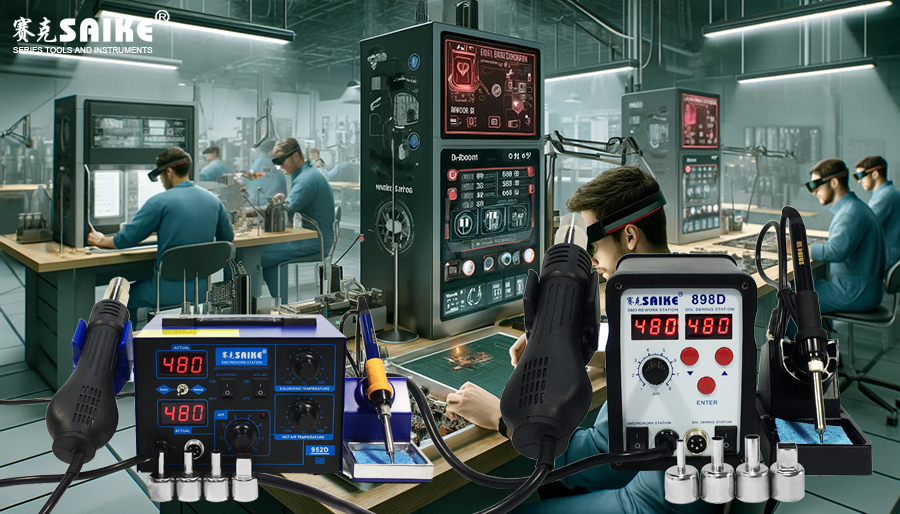
SK-YJ000RFCHT-KP 100008
Hot air rework stations are essential tools in electronic repair and assembly operations, but to fully utilize their functionality, they need to be paired with a range of auxiliary tools and materials. These tools and materials not only improve operational efficiency but also help protect electronic components and enhance the quality of repairs. This article will provide a detailed introduction to the necessary auxiliary tools and materials used in conjunction with hot air rework stations.
I. Auxiliary Tools
1.Electrostatic Protection Equipment:
– Anti-static wrist straps and mats: Preventing electrostatic buildup is crucial when handling sensitive electronic components. Anti-static wrist straps and mats effectively discharge static electricity, protecting components from electrostatic damage.
2.Precision Tweezers:
– Tweezers of different shapes: Used for precisely placing and picking up small electronic components. Stainless steel or chrome-plated tweezers are particularly important for preventing electrostatic damage.
3.Solder Paste and Flux:
– Solder paste: Used for soldering preparation, helping the solder to flow better and reducing soldering defects.
– Flux: Used to clean and prepare solder joints, improving soldering quality, especially on complex or dirty solder joints.
4.Solder Wire and Solder Wick:
– Solder wire: Used to add new solder to ensure reliable connections.
– Solder wick: Used to remove excess solder and clean solder joints, keeping the soldering area tidy.
5.Cleaning Brushes and Cleaners:
– Anti-static brushes: Used to clean dust and residues on circuit boards, preventing damage to components.
– Cleaners: Used to remove residual flux and other impurities from solder joints, usually choosing non-corrosive products that won’t damage the circuit board.
6.Heating Stage:
– Preheating stage: Used to preheat the entire work area or circuit board to a certain temperature, reducing thermal stress during hot air rework, especially useful when reworking large or multilayer circuit boards.
7.Microscope or Magnifying Glass:
– Inspection tools: When performing precision work, use a microscope or magnifying glass to inspect solder joints and component placement, ensuring there are no misalignments or soldering defects.
II. Necessary Materials
1.Heat Shrink Tubing:
– Used for insulation and protection of welded wires and connectors, tightly wrapped through the heat shrinking process, providing physical protection and electrical insulation.
2.Protective Tape:
– High-temperature tape: Used to protect sensitive components or mark areas during regional heating. High-temperature tape can remain stable during the heating process without leaving any residue.
3.Thermal Conductive Adhesive:
– Used to ensure thermal contact between the heat dissipation components and their heat sinks, enhancing cooling effects, often used for handling high-power components.
III. Summary
In summary, equipping suitable auxiliary tools and materials can maximize the efficiency of hot air rework stations, ensuring high efficiency and quality in electronic repair and manufacturing operations. When selecting these tools and materials, one should consider their quality, applicability, and compatibility with the equipment to achieve the best work results and operational safety.


